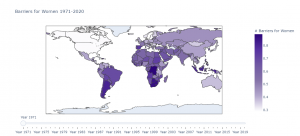Ananya Chaudhuri ’23 and Prof. Gisella Kagy
Over this summer I worked with Prof. Gisella Kagy in the Economics department, studying Gender Profit Gaps- trying to understand the reasons why women-owned firms have smaller outcomes. While the Ford project is part of a larger, global effort to understand and synthesize existing information about the gender profit gap, my work was about global data analysis.
An essential part of the project is understanding what the global business and policy environment is for women-owned enterprises (WOE) to contextualize individual country-level data. I started this process by analyzing and manipulating large global datasets like the World Bank Business and Law (WBL) survey and UCLA Gender Data. The datasets ask questions that assess the constraints that working women face in different countries like if they get maternity leave, if they can breastfeed at work, if they can travel outside the country, and so on. Using the program Stata, I changed the datasets to the desired form- reshaping and merging the datasets, creating and dropping variables, etc. Since the datasets were originally in different formats, having them in a form where they could be combined and analyzed was important.
I then converted the data into binaries and did calculations to create indices- numbers that quantified the barriers in a country. Using these values, I was able to create Chloropleth maps through Python. They are color-coded maps (the darker the color the higher the barriers) that show the global policy environment for specific years. The slider map can also show how barriers have changed from 1971 to 2020 if you slide the scale down. This allows us to represent our findings visually and check how trends have changed over time.
I also edited the project website which will, hopefully, become a resource for anyone researching gender profit gaps!

